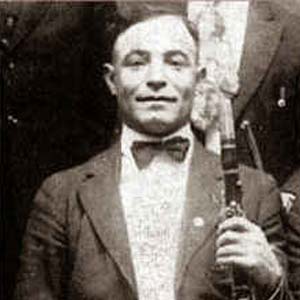Naftule Brandwein was not only one of the most influential musicians in the history of Klezmer music but one of this century’s truly eccentric personalities. Proclaiming himself, “the king of the Klezmer clarinet”, Brandwein brought innovation and excitement to the Jewish dance music that originated in eastern Europe. According to “CMJ-NMR”, Brandwein was “the Charlie Parker of klezmer, a master musician of the 78 rpm era who influenced everyone in his field who came after him”.
As outrageous a personality as he was an imaginative musician, Brandwein often performed with a neon sign, that read “Naftule Brandwein Orchestra”, around his neck. In his liner notes to the 1997 album, “King Of The Klezmer Clarinet”, Klezmer historian Henry Sapoznik wrote of Brandwein walking onto a stage while wearing an Uncle Sam costume adorned with Christmas lights and nearly electrocuting himself.
One of thirteen children, Brandwein was descended from the Strettener Hasidic dynasty of Rabbi Yehuda Hersch Brandwein of Stratyn, Poland. His father played fiddle and was an improvisatory wedding poet. His older brother, Azriel, played clarinet and served as his first music teacher. Emigrating to the United States in 1908, Brandwein attracted attention as a Yiddish Theater musician. His earliest recordings came as a member of Abe Schwartz’s Orchestra, with whom he played until 1923 when he launched his solo career. His spot in the band was taken over by influential Klezmer clarinetist Dave Tarras. Although he played briefly with Joseph Cherniavsky’s Hasidic-American Jazz Band in the early-1920s, most of the twenty three tunes that Brandwein recorded between 1922 and 1927 came as a bandleader.
In the mid-1920s, Brandwein’s fortune began to sour. Developing a reputation as a “nasty drunk”, he failed to appear for numerous gigs. At the same time, his traditional approach to klezmer music began to sound more and more out of date. Anti-immigration legislation passed in 1924 decreased the number of European immigrants who preferred his style of music. Following a recording session in October 1927, Brandwein did not record until 1941. Although he did not live long enough to see the klezmer revival of the 1980s, Brandwein had a major impact on younger generations of musicians.


10 thoughts on “Kaminos”
Was Nicholas related to Alexander Saslavsky who married Celeste Izolee Todd?
Anyone have a contact email for Yair Klinger or link to score for Ha-Bayta?
wish to have homeland concert video played on the big screen throughout North America.
can organize here in Santa Barbara California.
contacts for this needed and any ideas or suggestions welcomed.
Nat farber is my great grandpa 😊
Are there any movies or photos of max kletter? His wife’s sister was my stepmother, so I’m interested in seeing them and sharing them with his wife’s daughter.
The article says Sheb recorded his last song just 4 days before he died, but does not tell us the name of it. I be curious what it was. I’d like to hear it.
Would anyone happen to know where I can find a copy of the sheet music for a Gil Aldema Choral (SATB) arrangement for Naomi Shemer’s “Sheleg Al Iri”. (Snow on my Village)?
Joseph Smith
Kol Ram Community Choir, NYC
שלום שמעון!
לא שכחתי אותך. עזבתי את ישראל בפברואר 1998 כדי להביא את בני האוטיסט לקבל את העזרה המקצועית שלא הייתה קיימת אז בישראל. זה סיפור מאוד עצוב וטרגי, אבל אני הייתי היחיד עם ביצים שהביא אותו והייתי הורה יחיד בשבילו במשך חמישה חודשים. הוא היה אז בן 9. כעת הוא בן 36 ומתפקד באופן עצמאי. נתתי לו הזדמנות לעתיד נורמלי. בטח, אבות כולם חרא, אומרים הפמינציות, אבל כולם צריכים לעבוד כמטרות במטווחי רובה!
משה קונג
(Maurice King)
Thank you for this wonderful remembrance of Herman Zalis. My late father, Henry Wahrman, was one of his students. Note the correct spelling of his name for future reference. Thank you again for sharing this.
Tirza Wahrman (Mitlak)
amazing zchuso yagein aleinu, he wrote the famous niggun Lefichuch that is sung in almost every Israeli Yeshiva